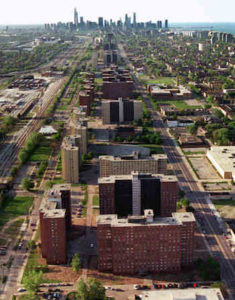
*The Robert Taylor Homes housing project began accepting residences on this date in 1962.
The Robert Taylor Homes were located in the Bronzeville neighborhood of the South Side of Chicago, on State Street between Pershing Road (39th Street) and 54th Street alongside the Dan Ryan Expressway. The Robert Taylor Homes housing project was completed in 1962 and named for Robert Taylor, a Black activist and Chicago Housing Authority (CHA) board member who, in 1950, resigned when the city council refused to endorse potential building locations throughout the city of Chicago that would induce racially integrated housing.
At one time, it was the largest housing project in the country, and it was intended to offer decent, affordable housing. It was composed of 28 high-rise buildings with 16 stories each, with a total of 4,321 apartments, mostly arranged in U-shaped clusters of three, stretching for two miles (three kilometers). The Robert Taylor Homes were where Mr. T, Kirby Puckett, and Deval Patrick, and others were raised. Robert Taylor Homes faced many of the same problems that doomed other high-rise housing projects in Chicago, such as Cabrini-Green. They included its share of drugs, violence, and poverty.
Planned for 11,000 inhabitants, the Robert Taylor Homes housed up to a peak of 27,000 people. Six of the poorest US census areas with populations above three people were found there. Including children who are not of working age, at one point, 95 percent of the housing development's 27,000 residents were unemployed and listed public assistance as their only income source, and 40 percent of the households were single-parent, female-headed households earning less than $5,000 per year and over 90 percent were African American. The 28 16-story concrete high-rises, many blackened with the scars of an arson fire, sat in a narrow two-block by 2.5-mile stretch. The city's neglect was evident in littered streets, poorly enforced building codes, and scarce commercial or civic services.
Police sources showed that the rising number of homicides resulted from the gang "turf wars" and drug dealers fighting for control of those Chicago neighborhoods. Its landlord, the Chicago Housing Authority (CHA), estimated that $45,000 in drug deals occurred daily. On June 25, 1983, a child, Vinyette Teague, was abducted from Robert Taylor Homes after her grandmother left her alone in the hallway for a few minutes to answer a phone call. An estimated 50 people were in the hallway at the time of the abduction, but police could not gather enough evidence to make any arrests. She has never been seen or heard from since.
In 1996, the CHA decided to replace all Robert Taylor Homes with a mixed-income community in low-rise buildings as part of a federal block grant received for the HOPE VI federal program. HOPE VI federal funds were granted specifically for off-site Taylor replacement housing. The Chicago Housing Authority moved out all residents by the end of 2005. On 8 March 2007, the last remaining building was demolished. As of 2007, a total of 2,300 low-rise residential homes and apartments, seven new and renovated community facilities, and several retail and commercial spaces were to be built in place of the old high-rise buildings. The development costs are expected to total an estimated $583 million. Part of the redevelopment was renaming the area "Legends South."
Francis Kuo and William Sullivan
Landscape and Human Health Laboratory
The University of Illinois at Urbana-Champagne.
Sudhir Alladi Venkatesh
American Project
(ISBN 0-674-00830-8).